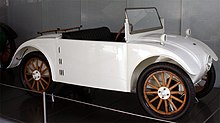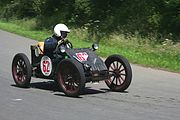Hanomag 2/10 PS
| Hanomag | |
|---|---|
|
Hanomag 2/10 PS (1925)
|
|
| 2/10 hp | |
| Production period: | 1925-1928 |
| Class : | Small car |
| Body versions : | Roadster , sedan , cabriolet , landaulet |
| Engines: |
Otto engine : 0.5 liter (10 hp) |
| Length: | 2780 mm |
| Width: | 1180 mm |
| Height: | 1600 mm |
| Wheelbase : | 1920 mm |
| Empty weight : | 370-430 kg |
| successor | Hanomag 3/16 PS |
The Hanomag 2/10 PS was a small car from the German manufacturer Hanomag from Hanover .
description
The 2/10 PS developed by Karl Pollich and Fidelis Böhler was the first German small car that was developed from 1924 and built and delivered in assembly line production from 1925 . This revolutionary, but also widely ridiculed car was nicknamed " Kommissbrot " because of its shape . Its single-cylinder four-stroke engine with 502 cm³ displacement (according to the tax formula: 499 cm³) and 10 HP (7.35 kW) installed transversely in front of the rear axle drove the rear axle with a rigid through drive or without a differential via a three-speed gearbox with gate shift and a chain. With this type of rear axle, only one brake drum was necessary, with the foot brake acting as an inner shoe brake and the hand brake acting as a band brake on the outside. The vibrations of the engine led to an uncomfortable bouncing motion when idling. The front wheels were suspended from two transverse leaf springs lying one above the other, the rigid rear axle was suspended from trailing arms with coil springs. To absorb shock, the axle supports rubbed with a friction lining on axle guides attached to the rear of the frame.
With a fuel consumption of 4.0 liters per 100 kilometers, it was the most economical mass-produced car that was produced in the interwar period . That was because at that time it was the only mass-produced car with a small single-cylinder engine.
The two-seater car weighed only 370 kg and reached a top speed of 60 km / h, the racing version 90 km / h. It only had one headlight (it was not until 1931 that a change in the law in Germany prescribed two headlights). The usual fenders and running boards were missing in order to gain space for the occupants, making the Hanomag 2/10 PS the first known automobile in the world with a pontoon shape . In order to achieve a high level of body rigidity, the right-hand drive bread roll only had a door on the left side. The car, available as a limousine , convertible and landaulet, cost just under 2000 to 2500 Reichsmarks , depending on the version . 15,775 units had been produced by 1928. Although the vehicle was conceptually a usable solution to the small car problem, the more expensive “real” small cars like the Dixi or the Opel Tree Frog achieved greater sales success.
Idiom: One kilo of sheet metal, one kilo of paint - and the Hanomag is ready!
Technical specifications
| Type | 2/10 hp |
| Construction period | 1925-1928 |
| Superstructures | R2, L2, Cb2, Ld2 |
| engine | 1 cylinder vertical 4-stroke (in the rear) |
| Valves | hanging (ohv) |
| Bore × stroke | 80 mm × 100 mm |
| Displacement | 502 cc |
| power | 10 hp (7.4 kW) at 2500 rpm |
| compression | 6: 1 |
| consumption | 4 l / 100 km |
| transmission | 3-speed |
| Top speed | 60 km / h |
| Empty weight | 370-430 kg |
| maximum weight allowed | 570-630 kg |
| Electrics | 6 volts |
| length | 2780 mm |
| width | 1180 mm |
| height | 1600 mm |
| wheelbase | 1920 mm |
| Front / rear track | 1040 mm / 910 mm |
| Turning circle | |
| wheel size | 27 "x 3.5" ND |
- L2 = 2-seater sedan
- R2 = 2-seater roadster
- Cb2 = 2-seater convertible
- Bd2 = 2-seater landaulet
Motorsport
Three Hanomag 2/10 PS took part in the opening race of the Nürburgring on June 19, 1927 in the class up to 750 cm³ . The driver Hellmuth Butenuth managed the 12 laps or 340.8 km on the total distance in 5: 36: 19.4 hours, which corresponded to an average speed of 60.8 km / h. The other two Hanomag failed. The cars were racing versions with free-standing wheels and without the typical body; they only had a bow fairing.
- Racing version of the Hanomag 2/10 PS
2007 at the DAMC 05 Oldtimer Festival
On the Nürburgringsüdschleife
Others
In the German film The Green Archer, based on the novel of the same name , the reporter Spike Holland, played by Eddi Arent , drives a white Hanomag 2/10 PS convertible.
The Hanomag 2/10 PS can z. B. can be viewed in Einbeck in the PS.Speicher . This is also possible in the premises of the Siegfried Grösche Foundation in Alfeld, which has the little Hanomag in its logo. The “Kommissbrot” there had been in the possession of the Grösche family since 1930 and was transferred to the foundation in 2001. In late summer 2016, it returned to the streets in and around Alfeld after a long period of inactivity.
literature
- Dieter Tasch : Automobile history “Made in Hanover”. The commissary bread from Hanomag , catalog for the exhibition in 1990 under the title 750 years of traffic in & around Hanover , ed. from the development association for the establishment of the Museum of Industry and Work eV in cooperation with the Norddeutsche Landesbank, Girozentrale, Hanover: Norddeutsche Landesbank, 1995
- The Hanomag-Kommissbrot in his time , in his . Horst-Dieter Görg, Torsten Hamacher (Ed.), With the assistance of Ernst Bergner et al. : Hanomag passenger car. From Hanover into the world. The automobile manufacture of the traditional Hanover company, 1924–51. From original beginnings to top engineering achievements , 1st edition, Soltau: Mundschenk, 1999, ISBN 3-933802-02-4 , pp. 14–51
- Horst-Dieter Görg: 80 years of Hanomag Kommissbrot. Germany's first Volks-Wagen. Stories and documents about the “Little Hanomag” since 1924 , Soltau: Mundschenk, 2005, ISBN 3-933802-13-X
- Waldemar R. Röhrbein : Hanomag - Kommissbrot In: Klaus Mlynek, Waldemar R. Röhrbein (ed.) U. a .: City Lexicon Hanover . From the beginning to the present. Schlütersche, Hannover 2009, ISBN 978-3-89993-662-9 , p. 268.
- Horst-Dieter Görg, Dieter Tasch: Kommissbrot for all cases. The history of the Hanoverian small car from Hanomag , in this. (Ed.): It all began in Hanover ... biscuits - bread rolls - calculating machines. About personalities, traditional companies and milestones in the history of technology , with contributions by Torsten Hamacher…, in cooperation with the Technik-Forum Hannover eV, 1st edition, Hannover: Leuenhagen & Paris, 2011, ISBN 978-3-923976-84-3 , Pp. 56-63
source
- Werner Oswald : German Cars 1920–1945. 10th edition, Motorbuch Verlag, Stuttgart 1996, ISBN 3-87943-519-7 .
Web links
Individual evidence
- ↑ The bread of the early years , autobild, May 6, 2010
- ^ Gebauer / Buck: The chassis of the passenger car. Stuttgart 1956.
- ↑ "80 years Hanomag Kommißbrot: Germany's first people's car" (Horst-Dieter Görg, 2005, ISBN 3-933802-13-X )
- ↑ Michael Behrndt, Jörg-Thomas Födisch, Matthias Behrndt: ADAC Eifelrennen . Heel Verlag, Königswinter 2009, ISBN 978-3-86852-070-5 , pp. 17, 244.
- ↑ "Per steep section"
- ↑ PS.Speicher - great oldtimer in Einbeck. - Edle-Oldtimer.de. Retrieved September 7, 2017 .
- ↑ Legal notice of the Oldtimer Foundation. Retrieved September 28, 2018 .
6. Siegfried Grösche Foundation, https://www.oldtimer-stiftung.de









